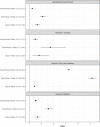Structural vulnerability to narcotics-driven firearm violence: An ethnographic and epidemiological study of Philadelphia's Puerto Rican inner-city
- PMID: 31751394
- PMCID: PMC6872141
- DOI: 10.1371/journal.pone.0225376
Structural vulnerability to narcotics-driven firearm violence: An ethnographic and epidemiological study of Philadelphia's Puerto Rican inner-city
Abstract
Background: The United States is experiencing a continuing crisis of gun violence, and economically marginalized and racially segregated inner-city areas are among the most affected. To decrease this violence, public health interventions must engage with the complex social factors and structural drivers-especially with regard to the clandestine sale of narcotics-that have turned the neighborhood streets of specific vulnerable subgroups into concrete killing fields. Here we present a mixed-methods ethnographic and epidemiological assessment of narcotics-driven firearm violence in Philadelphia's impoverished, majority Puerto Rican neighborhoods.
Methods: Using an exploratory sequential study design, we formulated hypotheses about ethnic/racial vulnerability to violence, based on half a dozen years of intensive participant-observation ethnographic fieldwork. We subsequently tested them statistically, by combining geo-referenced incidents of narcotics- and firearm-related crime from the Philadelphia police department with census information representing race and poverty levels. We explored the racialized relationships between poverty, narcotics, and violence, melding ethnography, graphing, and Poisson regression.
Findings: Even controlling for poverty levels, impoverished majority-Puerto Rican areas in Philadelphia are exposed to significantly higher levels of gun violence than majority-white or black neighborhoods. Our mixed methods data suggest that this reflects the unique social position of these neighborhoods as a racial meeting ground in deeply segregated Philadelphia, which has converted them into a retail endpoint for the sale of astronomical levels of narcotics.
Implications: We document racial/ethnic and economic disparities in exposure to firearm violence and contextualize them ethnographically in the lived experience of community members. The exceptionally concentrated and high-volume retail narcotics trade, and the violence it generates in Philadelphia's poor Puerto Rican neighborhoods, reflect unique structural vulnerability and cultural factors. For most young people in these areas, the narcotics economy is the most readily accessible form of employment and social mobility. The performance of violence is an implicit part of survival in these lucrative, illegal narcotics markets, as well as in the overcrowded jails and prisons through which entry-level sellers cycle chronically. To address the structural drivers of violence, an inner-city Marshall Plan is needed that should include well-funded formal employment programs, gun control, re-training police officers to curb the routinization of brutality, reform of criminal justice to prioritize rehabilitation over punishment, and decriminalization of narcotics possession and low-level sales.
Conflict of interest statement
Dr. Philippe Bourgois was a Guest Editor for the Substance Use, Misuse and Dependence: Prevention and Treatment special collection, however, he played no role in reviewing this manuscript. No other competing interests exist.
Figures






References
-
- Auyero J, Bourgois P, Scheper-Hughes N. Violence at the Urban Margins. Cambridge: Oxford University Press; 2015.
-
- Contreras R. The Stickup Kids: Race, Drugs, Violence, and the American Dream. Berkely, California: University of Califronia Press; 2013.

